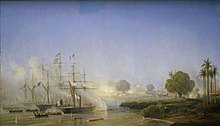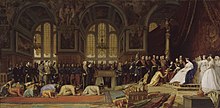French colonial empire
French colonial empire Empire colonial français (French) | |||||||||||
|---|---|---|---|---|---|---|---|---|---|---|---|
| 1534–1980[1][2] | |||||||||||
|
Left: Royal Standard of France (before 1792) Right: Flag of the French Empire and the French Republic | |||||||||||
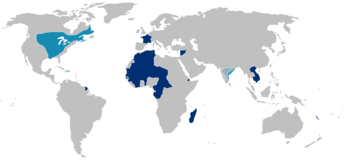 The First (light blue) and Second (dark blue) French colonial empires | |||||||||||
| Status | Colonial empire | ||||||||||
| Capital | Paris | ||||||||||
| Religion | Catholicism, Islam, Judaism,[3] Louisiana Voodoo,[4] Haitian Vodou,[5] Buddhism,[6] Hinduism[7] | ||||||||||
| History | |||||||||||
| 1534 | |||||||||||
| 1803 | |||||||||||
| 1830–1903 | |||||||||||
| 1946 | |||||||||||
| 1958 | |||||||||||
• Independence of Vanuatu | 1980[1][2] | ||||||||||
| Currency | French franc and various other currencies | ||||||||||
| ISO 3166 code | FR | ||||||||||
| |||||||||||
The French colonial empire (French: Empire colonial français) comprised the overseas colonies, protectorates, and mandate territories that came under French rule from the 16th century onward. A distinction is generally made between the "First French colonial empire", that existed until 1814, by which time most of it had been lost or sold, and the "Second French colonial empire", which began with the conquest of Algiers in 1830. On the eve of World War I, France's colonial empire was the second-largest in the world after the British Empire.
France began to establish colonies in the Americas, the Caribbean, and India in the 16th century but lost most of its possessions after its defeat in the Seven Years' War. The North American possessions were lost to Britain and Spain, but Spain later returned Louisiana to France in 1800. The territory was then sold to the United States in 1803. France rebuilt a new empire mostly after 1850, concentrating chiefly in Africa as well as Indochina and the South Pacific. As it developed, the new French empire took on roles of trade with the metropole, supplying raw materials and purchasing manufactured items. Especially after the disastrous Franco-Prussian War, which saw Germany become the leading economic and military power of Continental Europe, acquiring colonies and rebuilding an empire was seen as a way to restore French prestige in the world. It was also to provide manpower during the world wars.[8]
A major goal was the Mission civilisatrice or "Civilizing Mission".[9][10] In 1884, the leading proponent of colonialism, Jules Ferry, declared: "The higher races have a right over the lower races, they have a duty to civilize the inferior races." Full citizenship rights – assimilation – were offered, although in reality "assimilation was always receding [and] the colonial populations treated like subjects not citizens."[11] France sent small numbers of settlers to its empire, with the notable exception of Algeria, where the French settlers took power while being a minority.[12]
In World War II, Charles de Gaulle and the Free French took control of the overseas colonies one-by-one and used them as bases from which they prepared to liberate France. Historian Tony Chafer argues: "In an effort to restore its world-power status after the humiliation of defeat and occupation, France was eager to maintain its overseas empire at the end of the Second World War."[13] However, after 1945, anti-colonial movements began to challenge European authority. Revolts in Indochina and Algeria proved costly and France lost both colonies. After these conflicts, a relatively peaceful decolonization took place elsewhere after 1960. The French Constitution of 27 October 1946 (Fourth French Republic) established the French Union, which endured until 1958. Newer remnants of the colonial empire were integrated into France as overseas departments and territories within the French Republic. These now total altogether 119,394 km2 (46,098 sq. miles), with 2.8 million people in 2021. Links between France and its former colonies persist through La francophonie, the CFA franc, and joint military operations such as Operation Serval.
First French colonial empire (16th century to 1814)
The Americas

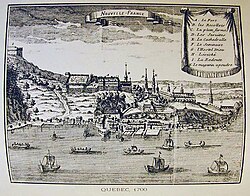
During the 16th century, the French colonization of the Americas began. Excursions of Giovanni da Verrazzano and Jacques Cartier in the early 16th century, as well as the frequent voyages of French boats and fishermen to the Grand Banks off Newfoundland throughout that century, were the precursors to the story of France's colonial expansion.[14] But Spain's defense of its American monopoly, and the further distractions caused in France itself in the later 16th century by the French Wars of Religion, prevented any constant efforts by France to settle colonies. Early French attempts to found colonies in Brazil, in 1555 at Rio de Janeiro ("France Antarctique") and in Florida (including Fort Caroline in 1562), and in 1612 at São Luís ("France Équinoxiale"), were not successful, due to a lack of official interest and to Portuguese and Spanish vigilance.[15]
The story of France's colonial empire truly began on 27 July 1605, with the foundation of Port Royal in the colony of Acadia in North America, in what is now Nova Scotia, Canada. A few years later, in 1608, Samuel de Champlain founded Quebec, which was to become the capital of the enormous, but sparsely settled, fur-trading colony of New France (also called Canada).[16]
New France had a rather small population, which resulted from more emphasis being placed on the fur trade rather than agricultural settlements. Due to this emphasis, the French relied heavily on creating friendly contacts with the local First Nations community. Without the appetite of New England for land, and by relying solely on Aboriginals to supply them with fur at the trading posts, the French composed a complex series of military, commercial, and diplomatic connections. These became the most enduring alliances between the French and the First Nation community. The French were, however, under pressure from religious orders to convert them to Catholicism.[17]
Through alliances with various Native American tribes, the French were able to exert a loose control over much of the North American continent. Areas of French settlement were generally limited to the St. Lawrence River Valley. Prior to the establishment of the 1663 Sovereign Council, the territories of New France were developed as mercantile colonies. It is only after the arrival of intendant Jean Talon in 1665 that France gave its American colonies the proper means to develop population colonies comparable to that of the British. Acadia itself was lost to the British in the Treaty of Utrecht in 1713. Back in France, there was relatively little interest in colonialism, which concentrated rather on dominance within Europe, and for most of its history, New France was far behind the British North American colonies in both population and economic development.[18][19]
In 1699, French territorial claims in North America expanded still further, with the foundation of Louisiana in the basin of the Mississippi River. The extensive trading network throughout the region connected to Canada through the Great Lakes, was maintained through a vast system of fortifications, many of them centred in the Illinois Country and in present-day Arkansas.[20]
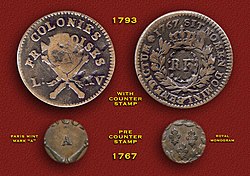
As the French empire in North America grew, the French also began to build a smaller but more profitable empire in the West Indies. Settlement along the South American coast in what is today French Guiana began in 1624, and a colony was founded on Saint Kitts in 1625 (the island had to be shared with the English until the Treaty of Utrecht in 1713, when it was ceded outright). The current isle of the Commonwealth of Dominica in the eastern Caribbean also fell under increasing French settlement from the early 1630s. The Compagnie des Îles de l'Amérique founded colonies in Guadeloupe and Martinique in 1635, and a colony was later founded on Saint Lucia by (1650). The food-producing plantations of these colonies were built and sustained through slavery, with the supply of slaves dependent on the African slave trade. Local resistance by the indigenous peoples resulted in the Carib Expulsion of 1660.[21] France's most important Caribbean colonial possession was established in 1664, when the colony of Saint-Domingue (today's Haiti) was founded on the western half of the Spanish island of Hispaniola. In the 18th century, Saint-Domingue grew to be the richest sugar colony in the Caribbean. The eastern half of Hispaniola (today's Dominican Republic) also came under French rule for a short period, after being given to France by Spain in 1795.[22]
Asia
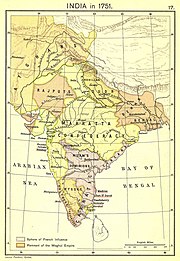
With the end of the French Wars of Religion, King Henry IV encouraged various enterprises to establish trade with the African and Asian continents. In December 1600, a company was formed through the association of Saint-Malo, Laval, and Vitré to trade with the Moluccas and Japan.[23] Two ships, the Croissant and the Corbin, were sent around the Cape of Good Hope in May 1601. One was wrecked in the Maldives, leading to the adventure of François Pyrard de Laval, who managed to return to France in 1611.[23][24] The second ship, carrying François Martin de Vitré, reached Ceylon and traded with Aceh in Sumatra, but was captured by the Dutch on the return leg at Cape Finisterre.[23][24] François Martin de Vitré was the first Frenchman to write an account of travels to the Far East in 1604, at the request of Henry IV, and from that time numerous accounts on Asia would be published.[25]
From 1604 to 1609, following the return of François Martin de Vitré, Henry developed a strong enthusiasm for travel to Asia and attempted to set up a French East India Company on the model of England and the Netherlands.[24][25][26] On 1 June 1604, he issued letters patent to Dieppe merchants to form the Dieppe Company, giving them exclusive rights to Asian trade for 15 years. No ships were sent, however, until 1616.[23] In 1609, another adventurer, Pierre-Olivier Malherbe, returned from a circumnavigation of the globe and informed Henry of his adventures.[25] He had visited China and India and had an encounter with Akbar.[25]
Colonies were established in India's Chandernagore (1673) and Pondichéry in the south east (1674), and later at Yanam (1723), Mahe (1725), and Karikal (1739) (see French India).
In 1664, the French East India Company was established to compete for trade in the east.
Africa
Although initial French colonization primarily occurred in the Americas and in Asia, the French did establish a few colonies and trading posts on the African continent. Initial French colonization in Africa began in modern-day Senegal, Madagascar, and along the Mascarene Islands. Initial French colonial projects, partially administered by the French East India Company, prioritized plantation economies and slave labor. These economies were based on monoculture agriculture and forced African labor. Poor living conditions, famines, and disease made enslaved labor conditions particularly lethal across French colonies. French presence in Senegal began in 1626, although formal colonies and trading posts were not established until 1659 with the founding of Saint-Louis, and 1677 with the founding of Gorée.[27] Additionally, the first settlement of Madagascar began in 1642 with the establishment of Fort Dauphin.[28]

Initial French colonial expansion in Senegal and Madagascar was primarily motivated by desires to secure access to natural resources including gum arabic, groundnuts (or peanuts) and other raw materials.[29] In addition they were further motivated by desires throughout the 17th and 19th century to secure access to and to control the slave trade.[29] Through an emphasis on controlling seaports, the French sought to forcibly extract enslaved people to send them abroad for profit.
Colonial development prioritized export oriented production while local industry remained very underdeveloped.[30] There was high development of production for export oriented production, notably of ground nuts in Senegal.[30] In additional coastal areas, the French set up slave plantations. Initial French development prioritized the building of roads to connect natural resources to harbors and ports.[30]
Additional initial French settlements were established on the Mascarene Islands which include Reunion Island, Mauritius, and Rodrigues. Reunion Island was first settled in 1642 and was administered by the French East India Company starting in 1665.[31]
After initial settlement by the Netherlands, France took control of Mauritius, which it renamed the Island of France in 1721.[32] Furthermore, France took control of Rodrigues in 1735 and Seychelles in 1756.[32]
On Reunion Island (Bourbon Island), the French East India Company first introduced the slave trade in the 1730s.[31] The French East India Company additionally introduced coffee and sought to create a plantation economy centered around forced labor.[31]
Characteristic of plantation colonies, the French colonists were a minority on Reunion Island. In 1763 there were only 4,000 French colonists while there were over 18,000 African enslaved people.[31] The majority of enslaved people on Reunion Island worked on coffee plantations. They primarily came from Madagascar, Mozambique, and Senegal.[31]
The economy of the Mauritius (Island of France) was similarly based on an exploitative plantation system dependent on forced African labor. The monoculture plantations farmed sugar cane, cotton, indigo, rice, and wheat.[31] Around 2,000 colonists and enslaved people from Reunion Island migrated to Mauritius.[31]
Conditions for enslaved people on the Mascarene Island plantations were very poor. Enslaved labor was highly lethal because of poor living conditions and famines.[33] After a series of crop failures from 1725 to 1737, as much as 10% of the islands' enslaved populations died due to famine and disease.[33]
Collapse of First French colonial empire
Colonial conflict with Britain


In the middle of the 18th century, a series of colonial conflicts began between France and Britain, which ultimately resulted in the destruction of most of the first French colonial empire and the near-complete expulsion of France from the Americas. These wars were the War of the Austrian Succession (1740–1748), the Seven Years' War (1756–1763), the American Revolution (1775–1783), the French Revolutionary Wars (1793–1802) and the Napoleonic Wars (1803–1815). It may even be seen further back in time to the first of the French and Indian Wars. This cyclic conflict is sometimes known as the Second Hundred Years' War.
Although the War of the Austrian Succession was indecisive – despite French successes in India under the French Governor-General Joseph François Dupleix and Europe under Marshal Saxe – the Seven Years' War, after early French successes in Menorca and North America, saw a French defeat, with the numerically superior British (over one million to about 50 thousand French settlers) conquering not only New France (excluding the small islands of Saint Pierre and Miquelon), but also most of France's West Indian (Caribbean) colonies, and all of the French Indian outposts.
While the peace treaty saw France's Indian outposts, and the Caribbean islands of Martinique and Guadeloupe restored to France, the competition for influence in India had been won by the British, and North America was entirely lost – most of New France was taken by Britain (also referred to as British North America), except Louisiana, which France ceded to Spain as payment for Spain's late entrance into the war (and as compensation for Britain's annexation of Spanish Florida). Also ceded to the British were Grenada and Saint Lucia in the West Indies. Although the loss of Canada would cause much regret in future generations, it excited little unhappiness at the time; colonialism was widely regarded as both unimportant to France, and immoral.[34]
Some recovery of the French colonial empire was made during the French intervention in the American Revolution, with Saint Lucia being returned to France by the Treaty of Paris in 1783, but not nearly as much as had been hoped for at the time of French intervention.
Haitian Revolution


True disaster came to what remained of France's colonial empire in 1791 when Saint Domingue (the Western third of the Caribbean island of Hispaniola), France's richest and most important colony, was riven by a massive slave revolt, caused partly by the divisions among the island's elite, which had resulted from the French Revolution of 1789.
The slaves, led eventually by Toussaint L'Ouverture and then, following his capture by the French in 1801, by Jean-Jacques Dessalines, held their own against French and British opponents. The French launched a failed expedition in 1802, and were up against a crippling Royal Naval blockade the following year. As a result, the Empire of Haiti ultimately achieved independence in 1804 (becoming the first black republic in the world, followed by Liberia in 1847).[35] The black and mulatto population of the island (including the Spanish east) had declined from 700,000 in 1789 to 351,819 in 1804. About 80,000 Haitians died in the 1802–03 campaign alone. Of the 55,131 French soldiers dispatched to Haiti in 1802–03, 45,000, including 18 generals, died, along with 10,000 sailors, the great majority from disease.[36] Captain [first name unknown] Sorrell of the British navy observed, "France lost there one of the finest armies she ever sent forth, composed of picked veterans, the conquerors of Italy and of German legions. She is now entirely deprived of her influence and her power in the West Indies."[37]
Meanwhile, France's newly resumed war with Britain resulted in the British capture of practically all remaining French colonies. These were restored at the Treaty of Amiens in 1802, but when war resumed in 1803, the British soon recaptured them. France's 1800 recovery of Louisiana from Spain in the secret Third Treaty of San Ildefonso came to nothing, as the success of the Haitian Revolution convinced Napoleon that holding Louisiana would not be worth the cost, leading to its sale to the United States in 1803.
Failed invasion of Egypt
The French attempt to establish a colony in Egypt in 1798–1801 was not successful. Battle casualties for the campaign were at least 15,000 killed or wounded and 8,500 prisoners for France; 50,000 killed or wounded and 15,000 prisoners for Turkey, Egypt, other Ottoman lands, and Britain.[38]
Second French colonial empire (post-1830)

At the close of the Napoleonic Wars, most of France's colonies were restored to it by Britain, notably Guadeloupe and Martinique in the West Indies, French Guiana on the coast of South America, various trading posts in Senegal, the Île Bourbon (Réunion) in the Indian Ocean, and France's tiny Indian possessions; however, Britain finally annexed Saint Lucia, Tobago, the Seychelles, and the Isle de France (now Mauritius).
In 1825 Charles X sent an expedition to Haïti, resulting in the Haiti indemnity controversy.[39]
The beginnings of the second French colonial empire were laid in 1830 with the French invasion of Algeria, which was fully conquered by 1903. Historian Ben Kiernan estimates that 825,000 Algerians died during the conquest by 1875.[40]
Africa
Morocco

The French Colonial Empire established a protectorate in Morocco between the years of 1912 to 1956. France's general approach to governing the protectorate of Morocco was a policy of in-direct rule where they co-opted existing governance systems to control the protectorate.[41] Specifically, the Moroccan elite and Sultan were both left in control while being strongly influenced by the French government.[41]
French colonialism in Morocco was discriminatory against native Moroccans and highly detrimental to the Moroccan economy. Moroccans were treated as second class citizens and discriminated against in all aspects of colonial life.[42] Infrastructure was discriminatory in colonial Morocco. The French colonial government built 36.5 kilometers of sewers in the new neighborhoods created to accommodate new French settlers while only 4.3 kilometers of sewers were built in indigenous Moroccan communities.[42] Additionally, land in Morocco was far more expensive for Moroccans than for French settlers. For example, while the average Moroccan had a plot of land 50 times smaller than their French settler counterparts, Moroccans were forced to pay 24% more per hectare.[42] Moroccans were additionally prohibited from buying land from French settlers.[42]
Colonial Morocco's economy was designed to benefit French businesses at the detriment of Moroccan laborers. Morocco was forced to import all of its goods from France despite higher costs.[42] Additionally, improvements to agriculture and irrigation systems in Morocco exclusively benefited colonial agriculturalists while leaving Moroccan farms at a technological disadvantage.[42]
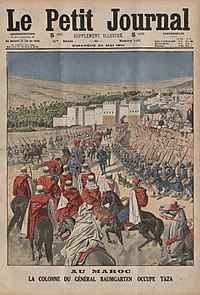
Between the years of 1914 to 1921 the Zaian Confederation of Berber Tribes, primarily from the Atlas Mountain region of Morocco, staged an armed resistance against French colonial control. The outbreak of World War One prevented the French from committing fully to the conflict, and thus the French forces suffered high losses.[43] For example, at the Battle of El Herri in 1914, 600 French soldiers were killed.[43] The fighting was primarily characterized by Guerrilla warfare. The Zaian forces additionally received military and economic support from the Central Powers.[43]
The Berber independence leader Abd el-Krim (1882–1963) organized armed resistance against the Spanish and French for control of Morocco. The Spanish had faced unrest off and on from the 1890s, but in 1921 Spanish forces were massacred at the Battle of Annual. El-Krim founded an independent Rif Republic that operated until 1926 but had no international recognition. Paris and Madrid agreed to collaborate to destroy it. They sent in 200,000 soldiers, forcing el-Krim to surrender in 1926; he was exiled in the Pacific until 1947. Morocco became quiet, and in 1936 became the base from which Francisco Franco launched his revolt against Madrid.[44]
Tunisia
The French protectorate of Tunisia lasted from 1881 to 1956. The protectorate was initially established after the successful invasion of Tunisia in 1881. The groundwork for occupation was laid on April 24, 1881, when the French deployed 35,000 troops from Algeria to invade several Tunisian cities.[45]
As in Morocco, the French governed indirectly and preserved the existing government structure. The bey remained an absolute monarch, Tunisian ministers were still appointed, although they were both subject to French authority.[46] Over time, the French gradually weakened the existing structures of power and centralized power into a French colonial administration.[45]
French West Africa
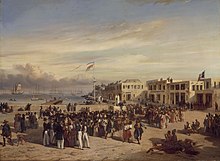
French West Africa was a confederation of eight other French colonial territories including French Mauritania, French Senegal, French Guinea, French Ivory Coast, French Niger, French Upper Volta, French Dahomey, French Togoland, and French Sudan.
At the beginning of Napoleon III's reign, the presence of France in Senegal was limited to a trading post on the island of Gorée, a narrow strip on the coast, the town of Saint-Louis, and a handful of trading posts in the interior. The economy had largely been based on the slave trade, carried out by the rulers of the small kingdoms of the interior, as well as elite families, until France abolished slavery in its colonies in 1848. In 1854, Napoleon III named an enterprising French officer, Louis Faidherbe, to govern and expand the colony, and to give it the beginning of a modern economy. Faidherbe built a series of forts along the Senegal River, formed alliances with leaders in the interior, and sent expeditions against those who resisted French rule. He built a new port at Dakar, established and protected telegraph lines and roads, followed these with a rail line between Dakar and Saint-Louis and another into the interior. He built schools, bridges, and systems to supply fresh water to the towns. He also introduced the large-scale cultivation of Bambara groundnuts and peanuts as a commercial crop. Reaching into the Niger valley, Senegal became the primary French base in West Africa and a model colony. Dakar became one of the most important cities of the French Empire and of Africa.[47]
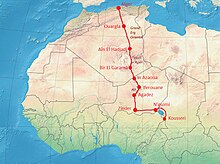
French Equatorial Africa
French Equatorial Africa was a confederation of French colonial possessions in the Sahel and Congo River regions of Africa. Colonies included in French Equatorial Africa include French Gabon, French Congo, Ubangui-Shari, and French Chad.
Cameroon
Cameroon was initially colonized by the German Empire in 1884. The indigenous people of Cameroon refused to work on German related projects, which turned into force labor. However, after World War One, the colony was partitioned by France and Britain. The French colony lasted from 1916 to until self-rule was achieved in 1960.[48]
Madagascar

French colonialism in Madagascar began in 1896 when France established a protectorate by force and ended in the 1960s with the beginning of self-rule.[49] Under French control, the colony of Madagascar included the dependencies of Comoros, Mayotte, Réunion, Kerguelen, Île Saint-Paul, Amsterdam Island, Crozet Islands, Bassas da India, Europa Island, Juan de Nova Island, Glorioso Islands, and Tromelin.
Algeria
The French conquest of Algeria began in 1830 with the invasion of Algiers, and was mostly completed by 1852. Not until 1903 was the conquest fully complete. French colonization of Algeria was undertaken through military conquest and the overthrow of existing structures of government. French colonial rule lasted until Algerian independence in 1962. French colonization of Algeria was defined by its lethality for indigenous Algerians, the dissolution of the Algerian government, and the creation of oppressive and segregationist structures which discriminated against the indigenous population.[50]

The French military invasion of Algeria began in 1830 with a naval blockade around Algeria followed by the landing of 37,000 French soldiers in Algeria.[51] The French captured the strategic port of Algiers in 1830 deposing Hussein Dey, the ruler of the Deylik of Algiers. They also seized other coastal communities.[52] Around 100,000 French soldiers were deployed in the conquest of Algeria. Algerian armed resistance against the French invasion[53] was mainly divided between forces of Ahmed Bey ben Mohamed Chérif at Constantine in the east, who was seeking to reinstate the Deylik of Algiers, and nationalist forces in the west and center. Treaties with the nationalists under Emir Abdelkader enabled the French to focus on the defeating of the remnants of the Deylik during the 1837 Siege of Constantine. Abdelkader continued to fight the French in the west until 1847. Between 500,000 and 1,000,000 Algerians, out of a total of 3 million, were killed during the French conquest as a result of war, massacres, disease and famine.[53][54][55] Famines and disease epidemics were partially caused by French confiscation of farmland from Algerians and the "scorched earth" tactics of razing farms and villages to quell Algerian resistance.[56] French losses from 1830 to 1851 were 3,336 killed in action and 92,329 dead in the hospital.[57][58]
There were about 100,000 European settlers in the country in 1852, at that time, about half of them French. Under the Second Republic the country was ruled by a civilian government, but Louis Napoleon re-established a military government, much to the annoyance of the colonists. By 1857 the army had conquered Kabyle Province, and pacified the country. By 1860 the European population had grown to 200,000, and lands of native Algerians were being rapidly bought and farmed by the new arrivals.[59]
In the first eight years of his rule Napoleon III paid little attention to Algeria. In September 1860, however, he and Empress Eugénie visited Algeria, and the trip made a deep impression upon them. Eugénie was invited to attend a traditional Arab wedding, and the Emperor met many of the local leaders. The Emperor gradually conceived the idea that Algeria should be governed differently from other colonies. In February 1863, he wrote a public letter to Pelissier, the Military Governor, saying: "Algeria is not a colony in the traditional sense, but an Arab kingdom; the local people have, like the colonists, a legal right to my protection. I am just as much the Emperor of the Arabs of Algeria as I am of the French." He intended to rule Algeria through a government of Arab aristocrats. Toward this end he invited the chiefs of main Algerian tribal groups to his chateau at Compiegne for hunting and festivities.[60]
Compared to previous administrations, Napoleon III was far more sympathetic to the native Algerians.[61] He halted European migration inland, restricting them to the coastal zone. He also freed the Algerian rebel leader Abd al Qadir (who had been promised freedom on surrender but was imprisoned by the previous administration) and gave him a stipend of 150,000 francs. He allowed Muslims to serve in the military and civil service on theoretically equal terms and allowed them to migrate to France. In addition, he gave the option of citizenship; however, for Muslims to take this option they had to accept all of the French civil code, including parts governing inheritance and marriage which conflicted with Muslim laws, and they had to reject the competence of religious Sharia courts. This was interpreted by some Muslims as requiring them to give up parts of their religion to obtain citizenship and was resented.

More importantly, Napoleon III changed the system of land tenure. While ostensibly well-intentioned, in effect this move destroyed the traditional system of land management and deprived many Algerians of land. While Napoleon did renounce state claims to tribal lands, he also began a process of dismantling tribal land ownership in favour of individual land ownership. This process was corrupted by French officials sympathetic to the French in Algeria who took much of the land they surveyed into public domain. In addition, many tribal leaders, chosen for loyalty to the French rather than influence in their tribe, immediately sold communal land for cash.[62]
His attempted reforms were interrupted in 1864 by an Arab insurrection, which required more than a year and an army of 85,000 soldiers to suppress. Nonetheless, he did not give up his idea of making Algeria a model where French colonists and Arabs could live and work together as equals. He traveled to Algiers for a second time on 3 May 1865, and this time he remained for a month, meeting with tribal leaders and local officials. He offered a wide amnesty to participants of the insurrection, and promised to name Arabs to high positions in his government. He also promised a large public works program of new ports, railroads, and roads. However, once again his plans met a major natural obstacle in 1866 and 1868, Algeria was struck by an epidemic of cholera, clouds of locusts, drought and famine, and his reforms were hindered by the French colonists, who voted massively against him in the plebiscites of his late reign.[63] Up to 500,000 people died from the famine and epidemics.[53]
In 1871, in response to prolonged famine and the French authorities' discriminatory treatment of Algerians, the Mokrani Revolt in the Kabylia erupted, which spread through much of Algeria. By April 1871, 250 tribes were rebelling. The uprising was defeated in 1872.[64] There were roughly 130,000 colonists in Algeria in 1871 and by 1900, there were one million.[65] In 1902, a French military expedition entered Hoggar Mountains and defeated the kingdom of Kel Ahaggar. The conquest of Algeria was fully completed in 1903 with the French in control of all Saharan lands in Algeria.[66]
Summary of additional colonization in Africa
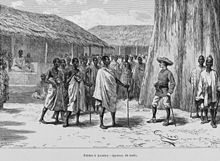
France also extended its influence in North Africa after 1870, establishing a protectorate in Tunisia in 1881 with the Bardo Treaty. Gradually, French control crystallised over much of North, West, and Central Africa by around the start of the 20th century (including the modern states of Mauritania, Senegal, Guinea, Mali, Ivory Coast, Benin, Niger, Chad, Central African Republic, Republic of the Congo, Gabon, Cameroon, the east African coastal enclave of Djibouti (Obock Territory), and the island of Madagascar.
Pierre Savorgnan de Brazza helped to formalise French control in Gabon and on the northern banks of the Congo River from the early 1880s. The explorer Colonel Parfait-Louis Monteil traveled from Senegal to Lake Chad in 1890–1892, signing treaties of friendship and protection with the rulers of several of the countries he passed through, and gaining much knowledge of the geography and politics of the region.[67]
The Voulet–Chanoine Mission, a military expedition, set out from Senegal in 1898 to conquer the Chad Basin and to unify all French territories in West Africa. This expedition operated jointly with two other expeditions, the Foureau–Lamy and Gentil Missions, which advanced from Algeria and Middle Congo respectively. With the death (April 1900) of the Muslim warlord Rabih az-Zubayr, the greatest ruler in the region, and the creation of the Military Territory of Chad (September 1900), the Voulet–Chanoine Mission had accomplished all its goals. The ruthlessness of the mission provoked a scandal in Paris.[68]

As a part of the Scramble for Africa, France aimed to establish a continuous west–east axis across the continent, in contrast with the proposed British north–south axis. Tensions between Britain and France heightened in Africa. At several points war seemed possible, but no outbreak occurred.[69] The most serious episode was the Fashoda Incident of 1898. French troops tried to claim an area in the Southern Sudan, and a British force purporting to act in the interests of the Khedive of Egypt arrived to confront them. Under heavy pressure, the French withdrew, implicitly acknowledging Anglo-Egyptian control over the area. An agreement between the two states recognised the status quo. The British were to maintain control over Egypt, while France remained the dominant power in Morocco. Still, it is commonly believed that France suffered a humiliating defeat overall.[70][71]
During the Agadir Crisis in 1911, Britain supported France against Germany, and Morocco became a French protectorate.
The French made their last major colonial gains after World War I, when they gained mandates over the former territories of the Ottoman Empire that make up what is now Syria and Lebanon, as well as most of the former German colonies of Togo and Cameroon.
Pacific Islands

In 1838, the French naval commander Abel Aubert du Petit-Thouars responded to complaints of the mistreatment of French Catholic missionary in the Kingdom of Tahiti ruled by Queen Pōmare IV. Dupetit Thouars forced the native government to pay an indemnity and sign a treaty of friendship with France respecting the rights of French subjects in the islands including any future Catholic missionaries. Four years later, claiming the Tahitians had violated the treaty, a French protectorate was forcibly installed and the queen made to sign a request for French protection.[72][73]
Queen Pōmare left her kingdom and exiled herself to Raiatea in protest against the French and tried to enlist the help of Queen Victoria. The Franco-Tahitian War broke out between the Tahitian people and the French from 1844 to 1847 as France attempted to consolidate their rule and extend their rule into the Leeward Islands where Queen Pōmare sought refuge with her relatives. The British remained officially neutral during the war but diplomatic tensions existed between the French and British. The French succeeded in subduing the guerilla forces on Tahiti but failed to hold the other islands. In February 1847, Queen Pōmare IV returned from her self-imposed exile and acquiesced to rule under the protectorate. Although victorious, the French were not able to annex the islands due to diplomatic pressure from Great Britain, so Tahiti and its dependency Moorea continued to be ruled under the protectorate. A clause to the war settlement, known as the Jarnac Convention or the Anglo-French Convention of 1847, was signed by France and Great Britain, in which the two powers agreed to respect the independence of Queen Pōmare's allies in Leeward Islands. The French continued the guise of protection until the 1880s when they formally annexed Tahiti with the abdication of King Pōmare V on 29 June 1880. The Leeward Islands were annexed through the Leewards War which ended in 1897. These conflicts and the annexation of other Pacific islands formed French Oceania.[73][74]
On 24 September 1853, Admiral Febvrier Despointes took formal possession of New Caledonia and Port-de-France (Nouméa) was founded 25 June 1854. A few dozen free settlers settled on the west coast in the following years, but New Caledonia became a penal colony and, from the 1860s until the end of the transportations in 1897, about 22,000 criminals and political prisoners were sent to New Caledonia.[75]

In contravention of the Jarnac Convention of 1847, the French placed the Leeward Islands under a provisional protectorate by falsely convincing the ruling chiefs that the German Empire planned to take over their island kingdoms. After years of diplomatic negotiation, Britain and France agreed to abrogate the convention in 1887 and the French formally annexed all the Leeward Islands without official treaties of cession from the islands' sovereign governments. From 1888 to 1897, the natives of the kingdom of Raiatea and Tahaa led by a minor chief, Teraupo'o, fought off French rule and the annexation of the Leeward Islands. Anti-French factions in the kingdom of Huahine also attempted to fight off the French under Queen Teuhe while the kingdom of Bora Bora remained neutral but hostile to the French. The conflict ended in 1897 with the capture and exile of rebel leaders to New Caledonia and more than one hundred rebels to the Marquesas. These conflicts and the annexation of other Pacific islands formed French Polynesia.[73][74]
At this time, the French also established colonies in the South Pacific, including New Caledonia, the various island groups which make up French Polynesia (including the Society Islands, the Marquesas, the Gambier Islands, the Austral Islands and the Tuamotus), and established joint control of the New Hebrides with Britain.[76]
Napoleon III: 1852–1870
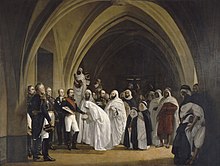
Napoleon III doubled the area of the French overseas Empire; he established French rule in New Caledonia, and Cochinchina, established a protectorate in Cambodia (1863); and colonized parts of Africa.
To carry out his new overseas projects, Napoleon III created a new Ministry of the Navy and the Colonies and appointed an energetic minister, Prosper, Marquis of Chasseloup-Laubat, to head it. A key part of the enterprise was the modernization of the French Navy; he began the construction of 15 powerful new battle cruisers powered by steam and driven by propellers; and a fleet of steam-powered troop transports. The French Navy became the second most powerful in the world, after Britain's. He also created a new force of colonial troops, including elite units of naval infantry, Zouaves, the Chasseurs d'Afrique, and Algerian sharpshooters, and he expanded the Foreign Legion, which had been founded in 1831 and won fame in the Crimea, Italy and Mexico. By the end of Napoleon III's reign, the French overseas territories had tripled in the area; in 1870 they covered a 1,000,000 km2 (390,000 sq mi), with more than 5 million inhabitants.[77]
Asia
Napoleon III also acted to increase the French presence in Indochina. An important factor in his decision was the belief that France risked becoming a second-rate power by not expanding its influence in East Asia. Deeper down was the sense that France owed the world a civilizing mission.[78]
French missionaries had been active in Vietnam since the 17th century, when the Jesuit priest Alexandre de Rhodes opened a mission there. In 1858 the Vietnamese emperor of the Nguyen dynasty felt threatened by the French influence and tried to expel the missionaries. Napoleon III sent a naval force of fourteen gunships, carrying three thousand French and three thousand Filipino troops provided by Spain, under Charles Rigault de Genouilly, to compel the government to accept the missionaries and to stop the persecution of Catholics. In September 1858 the expeditionary force captured and occupied the port of Da Nang, and then in February 1859 moved south and captured Saigon. The Vietnamese ruler was compelled to cede three provinces to France, and to offer protection to the Catholics. The French troops departed for a time to take part in the expedition to China, but in 1862, when the agreements were not fully followed by the Vietnamese emperor, they returned. The Emperor was forced to open treaty ports in Annam and Tonkin, and all of Cochinchina became a French territory in 1864.
In 1863, the ruler of Cambodia, King Norodom, who had been placed in power by the government of Thailand, rebelled against his sponsors and sought the protection of France. The Thai king granted authority over Cambodia to France, in exchange for two provinces of Laos, which were ceded by Cambodia to Thailand. In 1867, Cambodia formally became a protectorate of France.
-
Capture of Saigon by Charles Rigault de Genouilly on 18 February 1859, painted by Antoine Morel-Fatio
-
Napoleon III receiving the Siamese embassy at the palace of Fontainebleau in 1864
-
The Presidential Palace of Vietnam, in Hanoi, was built between 1900 and 1906 to house the French Governor-General of Indochina.
It was only after its defeat in the Franco-Prussian War of 1870–1871 and the founding of the Third Republic (1871–1940) that most of France's later colonial possessions were acquired. From their base in Cochinchina, the French took over Tonkin (in modern northern Vietnam) and Annam (in modern central Vietnam) and made them become French protectorates with the Treaty of Hue between France and Vietnam's Nguyen dynasty in 1883. These, together with Cambodia and Cochinchina, formed French Indochina in 1887 (to which Laos was added in 1893 and Guangzhouwanin 1900).[79]
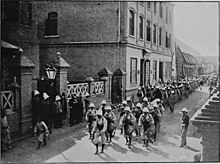
In 1849, the French Concession in Shanghai was established, and in 1860, the French Concession in Tientsin (now called Tianjin) was set up. Both concessions lasted until 1946.[80] The French also had smaller concessions in Guangzhou and Hankou (now part of Wuhan).[81]
The Third Anglo-Burmese War, in which Britain conquered and annexed the hitherto independent Upper Burma, was in part motivated by British apprehension at France advancing and gaining possession of territories near to Burma.
Middle East
In the spring of 1860, a war broke out in Lebanon, then part of the Ottoman Empire, between the Druze population and the Maronite Christians. The Ottoman authorities in Lebanon could not stop the violence, and it spread into neighboring Syria, with the massacre of many Christians. In Damascus, the Emir Abd-el-Kadr protected the Christians there against the Muslim rioters. Napoleon III felt obliged to intervene on behalf of the Christians, despite the opposition of London, which feared it would lead to a wider French presence in the Middle East. After long and difficult negotiations to obtain the approval of the British government, Napoleon III sent a French contingent of seven thousand men for a period of six months. The troops arrived in Beirut in August 1860, and took positions in the mountains between the Christian and Muslim communities. Napoleon III organized an international conference in Paris, where the country was placed under the rule of a Christian governor named by the Ottoman Sultan, which restored a fragile peace. The French troops departed in June 1861, after just under one year. The French intervention alarmed the British, but was highly popular with the powerful Catholic political faction in France, which had been alarmed by Louis Napoleon's dispute with the Pope over his territories in Italy.[82]

Despite the signing of the 1860 Cobden–Chevalier Treaty, a historic free trade agreement between Britain and France, and the joint operations conducted by France and Britain in the Crimea, China and Mexico, diplomatic relations between Britain and France never became close during the colonial era. Lord Palmerston, the British foreign minister from 1846 to 1851 and prime minister from 1855 to 1865, sought to maintain the balance of power in Europe; this rarely involved an alignment with France. In 1859 there were even briefly fears that France might try to invade Britain.[83] Palmerston was suspicious of France's interventions in Lebanon, Southeast Asia and Mexico. Palmerston was also concerned that France might intervene in the American Civil War (1861–65) on the side of the South.[84] The British also felt threatened by the construction of the Suez Canal (1859–1869) by Ferdinand de Lesseps in Egypt. They tried to oppose its completion by diplomatic pressures and by promoting revolts among workers.[85]
The Suez Canal was successfully built by a French-backed company, which was to remain under French control even after the British government acquired almost half of the shares.[86] Both nations saw it as vital to maintaining their influence and respective empire in East Africa and Asia. In 1882, ongoing civil disturbances in Egypt prompted Britain to intervene, extending a hand to France. France's leading expansionist Jules Ferry was out of office, and Paris allowed London to take effective control of Egypt.[87]
Evolution in the use of the term Empire between the years of 1870–1939
After the downfall of Napoleon III, few writers used the word 'empire', which had become associated with despotism, decadence, and weakness, preferring the word 'colonies'. However, by the 1880s and 1890s, as Republicans consolidated their control over the political system, increasing numbers of politicians, intellectuals and writers began using the phrase "colonial empire", linking it to republicanism and the French nation.[88]
Most Frenchmen ignored foreign affairs and colonial issues. In 1914 the chief pressure group was the Parti colonial, a coalition of 50 organizations with a combined total of only 5,000 members.[89][90]
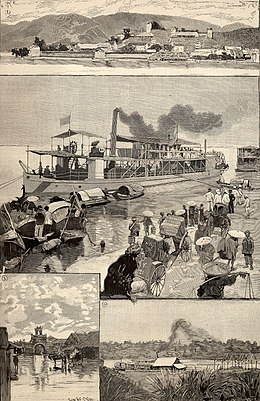
1. Panorama of Lac-Kaï, French outpost in China
2. Yun-nan, in the quay of Hanoi
3. Flooded street of Hanoi
4. Landing stage of Hanoi
Causes and justifications for colonialism
Civilizing Mission

A hallmark of the French colonial project in the late 19th century and early 20th century was the civilising mission (mission civilisatrice), the principle that it was Europe's duty to bring civilisation to benighted peoples.[91] As such, colonial officials undertook a policy of Franco-Europeanisation in French colonies, most notably French West Africa and Madagascar. During the 19th century, French citizenship along with the right to elect a deputy to the French Chamber of Deputies was granted to the four old colonies of Guadeloupe, Martinique, Guyanne and Réunion as well as to the residents of French India and the "Four Communes" in Senegal. In most cases, the elected deputies were white Frenchmen, although there were some blacks, such as the Senegalese Blaise Diagne, who was elected in 1914.[92] [93]
Racism and notions of white supremacy were integral to justifying the concept of the civilizing mission. French colonialists viewed non-European societies as uncivilized, and their colonial subjects as needing European re-education.[94] Racial darwinists like Arthur de Gobineau, justified this ideology by falsely claiming that people of color were biologically inferior to white people.[94]
Elsewhere, in the largest and most populous colonies, a strict separation between "sujets français" ("french subjects", natives) and "citoyens français" ("french citizens", people of European extraction) with different rights and duties was maintained until 1946. As was pointed out in a 1927 treatise on French colonial law, the granting of French citizenship to natives "was not a right, but rather a privilege".[95] Two 1912 decrees dealing with French West Africa and French Equatorial Africa enumerated the conditions that a native had to meet in order to be granted French citizenship (they included speaking and writing French, earning a decent living and displaying good moral standards). From 1830 to 1946, only between 3,000 and 6,000 Muslim native Algerians were granted French citizenship. In French West Africa, outside of the Four Communes, there were 2,500 "citoyens indigènes" out of a total population of 15 million.[96]
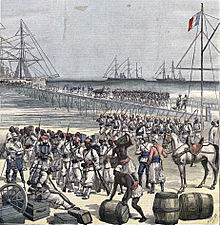
French conservatives had been denouncing the assimilationist policies as products of a dangerous liberal fantasy. In the Protectorate of Morocco, the French administration attempted to use urban planning and colonial education to prevent cultural mixing and to uphold the traditional society upon which the French depended for collaboration, with mixed results. After World War II, the segregationist approach modeled in Morocco had been discredited by its connections to Vichyism, and assimilationism enjoyed a brief renaissance.[92]
David P. Forsythe wrote: "From Senegal and Mauritania in the west to Niger in the east (what became French Africa), there was a parallel series of ruinous wars, resulting in tremendous numbers of people being violently enslaved. At the beginning of the twentieth century there may have been between 3 and 3.5 million slaves, representing over 30 percent of the total population, within this sparsely populated region."[97] In 1905, the French abolished slavery in most of French West Africa.[98] From 1906 to 1911, over a million slaves in French West Africa fled from their masters to earlier homes.[99] In Madagascar over 500,000 slaves were freed following French abolition in 1896.[100]
Education
French colonial officials, influenced by the revolutionary ideal of equality, standardized schools, curricula, and teaching methods as much as possible. They did not establish colonial school systems with the idea of furthering the ambitions of the local people, but rather simply exported the systems and methods in vogue in the mother nation.[101] Having a moderately trained lower bureaucracy was of great use to colonial officials.[102] The emerging French-educated indigenous elite saw little value in educating rural peoples.[103] After 1946 the policy was to bring the best students to Paris for advanced training. The result was to immerse the next generation of leaders in the growing anti-colonial diaspora centered in Paris. Impressionistic colonials could mingle with studious scholars or radical revolutionaries or so everything in between. Ho Chi Minh and other young radicals in Paris formed the French Communist party in 1920.[104]
Tunisia was exceptional. The colony was administered by Paul Cambon, who built an educational system for colonists and indigenous people alike that was closely modeled on mainland France. He emphasized female and vocational education. By independence, the quality of Tunisian education nearly equalled that in France.[105]
African nationalists rejected such a public education system, which they perceived as an attempt to retard African development and maintain colonial superiority. One of the first demands of the emerging nationalist movement after World War II was the introduction of full metropolitan-style education in French West Africa with its promise of equality with Europeans.[106][107]
In Algeria, the debate was polarized. The French set up schools based on the scientific method and French culture. The Pied-Noir (Catholic migrants from Europe) welcomed this. Those goals were rejected by the Moslem Arabs, who prized mental agility and their distinctive religious tradition. The Arabs refused to become patriotic and cultured Frenchmen and a unified educational system was impossible until the Pied-Noir and their Arab allies went into exile after 1962.[108]
Critics of French colonialism

Critics of French colonialism gained an international audience in the 1920s, and often used documentary reportage and access to agencies such as the League of Nations and the International Labour Organization to make their protests heard. The main criticism was the high level of violence and suffering among the natives. Major critics included Albert Londres, Félicien Challaye, and Paul Monet, whose books and articles were widely read.[109]
Decolonization
The French colonial empire began to fall during the Second World War, when various parts were occupied by foreign powers (Japan in Indochina, Britain in Syria, Lebanon, and Madagascar, the United States and Britain in Morocco and Algeria, and Germany and Italy in Tunisia). However, control was gradually reestablished by Charles de Gaulle. The French Union, included in the Constitution of 1946, nominally replaced the former colonial empire, but officials in Paris remained in full control. The colonies were given local assemblies with only limited local power and budgets. There emerged a group of elites, known as evolués, who were natives of the overseas territories but lived in metropolitan France.[110]
World War II

During World War II, allied Free France, often with British support, and Axis-aligned Vichy France struggled for control of the colonies, sometimes with outright military combat. By 1943, all of the colonies, except for Indochina under Japanese control, had joined the Free French cause.[111]
The overseas empire helped liberate France as 300,000 North African Arabs fought in the ranks of the Free French.[112] However Charles de Gaulle had no intention of liberating the colonies. He assembled the conference of colonial governors (excluding the nationalist leaders) in Brazzaville in January 1944 to announce plans for postwar Union that would replace the Empire.[113] The Brazzaville manifesto proclaimed:
- the goals of the work of civilization undertaken by France in the colonies exclude all idea of autonomy, all possibility of development outside the French block of the Empire; the possible constitutional self-government in the colonies is to be dismissed.[114]
The manifesto angered nationalists across the Empire, and set the stage for long-term wars in Indochina and Algeria that France would lose in humiliating fashion.
Conflict
France was immediately confronted with the beginnings of the decolonisation movement. In Algeria demonstrations in May 1945 were repressed with an estimated 6,000 to 45,000 Algerians killed.[115][116] Unrest in Haiphong, Indochina, in November 1945 was met by a warship bombarding the city.[117] Paul Ramadier's (SFIO) cabinet repressed the Malagasy Uprising in Madagascar in 1947. The French blamed education. French officials estimated the number of Malagasy killed from a low of 11,000 to a French Army estimate of 89,000.[118]
Also in Indochina, Ho Chi Minh's Viet Minh, which was backed by the Soviet Union and China, declared Vietnam's independence, which started the First Indochina War. The war dragged on until 1954, when the Viet Minh decisively defeated the French at the Battle of Điện Biên Phủ in northern Vietnam, which was the last major battle between the French and the Vietnamese in the First Indochina War.
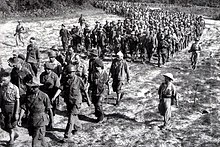
Following the Vietnamese victory at Điện Biên Phủ and the signing of the 1954 Geneva Accords, France agreed to withdraw its forces from all its colonies in French Indochina, while stipulating that Vietnam would be temporarily divided at the 17th parallel, with control of the north given to the Soviet-backed Viet Minh as the Democratic Republic of Vietnam under Ho Chi Minh, and the south becoming the State of Vietnam under former Nguyen-dynasty Emperor Bảo Đại, who abdicated following the 1945 August Revolution under pressure from Ho.[119][120] However, in 1955, the State of Vietnam's Prime Minister, Ngô Đình Diệm, toppled Bảo Đại in a fraud-ridden referendum and proclaimed himself president of the new Republic of Vietnam. The refusal of Ngô Đình Diệm, the US-supported president of the first Republic of Vietnam [RVN], to allow elections in 1956 – as had been stipulated by the Geneva Conference – in fear of Ho Chi Minh's victory and subsequently a total communist takeover,[121] eventually led to the Vietnam War.[122]
In France's African colonies, the Union of the Peoples of Cameroon's insurrection, which started in 1955 and headed by Ruben Um Nyobé, was violently repressed over a two-year period, with perhaps as many as 100 people killed. However, France formally relinquished its protectorate over Morocco and granted it independence in 1956.
French involvement in Algeria stretched back a century. The movements of Ferhat Abbas and Messali Hadj had marked the period between the two world wars, but both sides radicalised after the Second World War. In 1945, the Sétif massacre was carried out by the French army. The Algerian War started in 1954. Atrocities characterized both sides, and the number killed became highly controversial estimates that were made for propaganda purposes.[123] Algeria was a three-way conflict due to the large number of "pieds-noirs" (Europeans who had settled there in the 125 years of French rule). The political crisis in France caused the collapse of the Fourth Republic, as Charles de Gaulle returned to power in 1958 and finally pulled the French soldiers and settlers out of Algeria by 1962.[124][125]
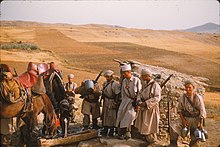
The French Union was replaced in the Constitution of 1958 by the French Community. Only Guinea refused by referendum to take part in the new organisation. However, the French Community ceased to operate before the end of the Algerian War. Almost all of the other former African colonies achieved independence in 1960. The French government refused to allow the populations of the former colonies the right they had in the new French Constitution of 1958, as French citizens with equal rights, to choose for their territories to become full départements of France. The French government had ensured that a constitutional law (60-525) was passed which removed the need for a referendum in a territory to confirm a change in status towards independence or départementalisation, so the voters who had rejected independence in 1958 were not consulted about it in 1960.[126] There are still a few former colonies that chose to remain part of France, under the status of overseas départements or territories.
Critics of neocolonialism claimed that the Françafrique had replaced formal direct rule. They argued that while de Gaulle was granting independence on one hand, he was maintaining French dominance through the operations of Jacques Foccart, his counsellor for African matters. Foccart supported in particular Biafra in the Nigerian Civil War during the late 1960s.[127]
Robert Aldrich argues that with Algerian independence in 1962, it appeared that the Empire practically had come to an end, as the remaining colonies were quite small and lacked active nationalist movements. However, there was trouble in French Somaliland (Djibouti), which became independent in 1977. There also were complications and delays in the New Hebrides Vanuatu, which was the last to gain independence in 1980. New Caledonia remains a special case under French suzerainty.[128] The Indian Ocean island of Mayotte voted in referendum in 1974 to retain its link with France and not become independent like the other three islands of the Comoro archipelago.[129]
Demographics
French census statistics from 1936 show an imperial population, outside of Metropolitan France itself, of 69.1 million people.[130] Of the total population, 16.1 million lived in North Africa, 25.5 million in sub-Saharan Africa, 3.2 million in the Middle East, 0.3 million in the Indian subcontinent, 23.2 million in East and South-East Asia, 0.15 million in the South Pacific, and 0.6 million in the Caribbean.[131]
The largest colonies were the general governorate of French Indochina (grouping five separate colonies and protectorates), with 23.0 million, the general governorate of French West Africa (grouping eight separate colonies), with 14.9 million, the general governorate of Algeria (grouping three departments and four Saharan territories), with 7.2 million, the protectorate of Morocco, with 6.3 million, the general governorate of French Equatorial Africa (grouping four separate colonies), with 3.9 million, and Madagascar and Dependencies (incl. the Comoro Islands), with 3.8 million.[131]
2.7 million Europeans (French and non-French citizens) and assimilated natives (non-European French citizens) lived in the French colonial empire in 1936 besides 66.4 million non-assimilated natives (French subjects but not citizens).[131] The majority of Europeans lived in North Africa. Non-European French citizens lived essentially in the four "old colonies" (Réunion, Martinique, Guadeloupe, and French Guiana), as well as in the Four Communes of Senegal (Saint-Louis, Dakar, Gorée, and Rufisque) and in the colonies of the South Pacific.
| 1921 | 1926 | 1931 | 1936 | |
|---|---|---|---|---|
| Metropolitan France | 39,140,000 | 40,710,000 | 41,550,000 | 41,500,000 |
| Colonies, protectorates, and mandates | 55,556,000 | 59,474,000 | 64,293,000 | 69,131,000 |
| Total | 94,696,000 | 100,184,000 | 105,843,000 | 110,631,000 |
| Percentage of the world population | 5.02% | 5.01% | 5.11% | 5.15% |
| Sources: INSEE,[132] SGF[130] | ||||
French settlers
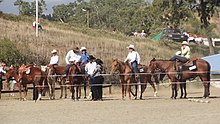
Unlike elsewhere in Europe, France experienced relatively low levels of emigration to the Americas, except for the Huguenots in British or Dutch colonies. France generally had close to the slowest natural population growth in Europe, and emigration pressures were therefore quite small[citation needed]. A small but significant emigration, numbering only in the tens of thousands, of mainly Roman Catholic French populations led to the settlement of the provinces of Acadia, Canada, and Louisiana, both (at the time) French possessions, and colonies in the West Indies, Mascarene islands and Africa. In New France, Huguenots were banned from settling in the territory, and Quebec was one of the most staunchly Catholic areas in the world until the Quiet Revolution. The current French Canadian population, which numbers in the millions, is descended almost entirely from New France's small settler population.
On 31 December 1687 a community of French Huguenots settled in South Africa. Most of these originally settled in the Cape Colony, but have since been quickly absorbed into the Afrikaner population. After Champlain's founding of Quebec City in 1608, it became the capital of New France. Encouraging settlement was difficult, and while some immigration did occur, by 1763 New France only had a population of some 65,000.[133]
In 1787, there were 30,000 white colonists on France's colony of Saint-Domingue. In 1804 Dessalines, the first ruler of an independent Haiti (St. Domingue), ordered the massacre of whites remaining on the island.[134] Out of the 40,000 inhabitants on Guadeloupe, at the end of the 17th century, there were more than 26,000 blacks and 9,000 whites.[135] Bill Marshall wrote, "The first French effort to colonize Guiana, in 1763, failed utterly when tropical diseases and climate killed all but 2,000 of the initial 12,000 settlers."[136]
French law made it easy for thousands of colons, ethnic or national French from former colonies of North and West Africa, India and Indochina, to live in mainland France. It is estimated that 20,000 colons were living in Saigon in 1945. 1.6 million European pieds noirs migrated from Algeria, Tunisia and Morocco.[137] In just a few months in 1962, 900,000 French Algerians left Algeria in the largest relocation of population in Europe since World War II.[138] In the 1970s, over 30,000 French colons left Cambodia during the Khmer Rouge regime as the Pol Pot government confiscated their farms and land properties. In November 2004, several thousand of the estimated 14,000 French nationals in Ivory Coast left the country after days of anti-white violence.[139]
Apart from French-Canadians (Québécois and Acadians), francophone Louisianians (Cajuns and Louisiana Creoles), and Métis, other populations of French ancestry outside metropolitan France include the Caldoches of New Caledonia, the so-called Zoreilles, Petits-blancs with the Franco-Mauritian of various Indian Ocean islands and the Beke people of the French West Indies.
Territories
Africa

- French Algeria (1830 - 1961)
- French Military Territory in Libya (1943 - 1951)
- French Protectorate in Morocco (1912 - 1956)
- French Protectorate of Tunisia (1881 - 1956)
- French West Africa (1895 - 1958)
- French Mauritania (1958 - 1960)
- French Senegal (1958 - 1960)
- French Guinea (1958 - 1960)
- French Ivory Coast (1958 - 1960)
- French Niger (1958 - 1960)
- French Upper Volta (1958 - 1960)
- French Dahomey (1958 - 1960)
- French Togoland (1958 - 1960)
- French Sudan (1959 - 1960)
- French Equatorial Africa (1910 - 1958)
- French Gabon (1958 - 1960)
- French Congo (1958 - 1960)
- Ubangui-Shari (1958 - 1960)
- French Chad (1958 - 1960)
- French Cameroon (1920 - 1960)
- French Madagascar (1897 - 1958)
- Seychelles (1756 - 1794)
- Île de France (Mauritius) (1715 - 1810)
- Comoros (1841 - 1975)
- Mayotte (1843 -)
- Réunion (1665 -)
- Kerguelen (1924 -)
- Île Saint-Paul (1924 -)
- Amsterdam Island (1924 -)
- Crozet Islands (1772 -)
- Bassas da India (1897 -)
- Europa Island (1897 )
- Juan de Nova Island (1897 -)
- Glorioso Islands (1892 -)
- Tromelin (1722 -)
- French Somalia (1896 - 1967)
- French domains of St Helena (1854 -)
Asia
- French mandate of Syria (1923 - 1946)
- Greater Lebanon (1923 - 1943)
- French India (1673 - 1950)
- French Indochina (1887 - 1954)
- French Cochinchina (1862 - 1946)
- Tonkin (1883 - 1887)
- Annam (1883 - 1950)
- French protectorate of Cambodia (1863 - 1956)
- French protectorate of Laos (1893 - 1953)
- Leased territory of Guangzhouwan (1898 - 1945)
- China concessions
- French concession in Tianjin (1896 - 1943)
- Shanghai French Concession (1896 - 1943)
- Shamian Island, Guangzhou (1896 - 1943)
The Caribbean
- Commonwealth of Dominica (1690 - 1763)
- Grenada (1649 -1763)
- Guadeloupe (1635 -)
- Haiti (1697 - 1804)
- Martinique (1635 -)
- Saint Barthélemy (1878 -)
- Saint Lucia (1674 - 1814)
- Saint Martin (1648-)
- Dominican Republic (1795 - 1815)
- Virgin Islands
- Saint Croix (1664 - 1733)
- Vieques (1698 - 1811)
South America
- France Antarctique (1555 -1567)
- French Guiana (1503 -)
- Equinoctial France (1612 - 1615)
North America
- New France (1534 – 1763)
- Acadia (1604 – 1713)
- Illinois Country (1675 – 1769), (1801 – 1803)
- Canada (1535 – 1763)
- Louisiana (1682 – 1762), (1801 – 1803)
- Newfoundland (1658 – 1713)
- Saint Pierre and Miquelon (1536-)
Oceania
- New Caledonia (1853 -)
- French Polynesia (1842 -)
- Wallis and Futuna (1887 -)
- Clipperton Island (1858 -)
- New Hebrides (1887 - 1980)
See also
- Army of the Levant
- CFA franc
- Colonialism
- Decolonization
- Evolution of the French Empire
- Francization
- French Army units with a tradition of service overseas
- 1900–1958: Troupes de marine
- 1900–1958: Troupes coloniales
- Tirailleurs
- Spahis
- Zouaves
- French colonial flags
- French colonisation of the Americas
- French law on colonialism (for teachers, 2005)
- History of France
- International relations of the Great Powers (1814–1919)
- List of French possessions and colonies
- New France
- Organisation internationale de la Francophonie
- Overseas France
- Postage stamps of the French colonies
- Scramble for Africa
- Timeline of imperialism
References
- ^ Robert Aldrich, Greater France: A History of French Overseas Expansion (1996) p 304
- ^ Melvin E. Page, ed. (2003). Colonialism: An International Social, Cultural, and Political Encyclopedia. ABC-CLIO. p. 218. ISBN 9781576073353.
- ^ Hyman, Paula (1998). The Jews of modern France. Berkeley: University of California Press. ISBN 9780520919297. OCLC 44955842.
- ^ Hinson, Glenn; Ferris, William (2010), The New Encyclopedia of Southern Culture: Volume 14: Folklife, University of North Carolina Press, p. 241, ISBN 9780807898550
- ^ Gordon, Leah (2000). The Book of Vodou. Barron's Educational Series. ISBN 0-7641-5249-1.
- ^ Jerryson, Michael K. (2017). The Oxford Handbook of Contemporary Buddhism. Oxford University Press. p. 279. ISBN 9780199362387.
- ^ Heenan, Patrick; Lamontagne, Monique, eds. (2014). The South America Handbook. Routledge. p. 318. ISBN 9781135973216.
- ^ Tony Chafer (2002). The End of Empire in French West Africa: France's Successful Decolonization?. Berg. pp. 84–85. ISBN 9781859735572.
- ^ Herbert Ingram Priestley (2018). France Overseas: A Study of Modern Imperialism. Routledge. p. 192. ISBN 9781351002417.
- ^ Mathew Burrows, "'Mission civilisatrice': French cultural policy in the Middle East, 1860–1914." Historical Journal 29.1 (1986): 109–135.
- ^ Julian Jackson, The Other Empire, Radio 3
- ^ Barclay, Fiona; Chopin, Charlotte Ann; Evans, Martin (3 April 2018). "Introduction: settler colonialism and French Algeria". Settler Colonial Studies. 8 (2): 115–130. doi:10.1080/2201473X.2016.1273862. hdl:1893/25105. ISSN 2201-473X. S2CID 151527670.
- ^ Tony Chafer, The end of empire in French West Africa: France's successful decolonization? (2002)see Chafer abstract Archived 14 March 2017 at the Wayback Machine
- ^ Singer, Barnett; Langdon, John (2008). Cultured Force: Makers and Defenders of the French Colonial Empire. University of Wisconsin Press. p. 24. ISBN 9780299199043.
- ^ Steven R. Pendery, "A Survey of French Fortifications in the New World, 1530–1650." in First Forts: Essays on the Archaeology of Proto-colonial Fortifications ed by Eric Klingelhofer (Brill 2010) pp. 41–64.
- ^ Marcel Trudel, The Beginnings of New France, 1524–1663 (McClelland & Stewart, 1973).
- ^ James R. Miller, Skyscrapers hide the heavens: A history of Indian-white relations in Canada (University of Toronto Press, 2000).
- ^ Edward Robert Adair, "France and the Beginnings of New France." Canadian Historical Review 25.3 (1944): 246–278.
- ^ Helen Dewar, "Canada or Guadeloupe?: French and British Perceptions of Empire, 1760–1762." Canadian Historical Review 91.4 (2010): 637–660.
- ^ Carl J. Ekberg, French roots in the Illinois country: The Mississippi frontier in colonial times (U of Illinois Press, 2000).
- ^ Paul Cheney, Revolutionary Commerce: Globalization and the French Monarchy (2010)
- ^ H.P.Davis, Black Democracy The Story of Haiti (1928) pp 16–86 online free
- ^ a b c d Asia in the Making of Europe, Volume III: A Century of Advance. Book 1, Donald F. Lach pp. 93–94 [1]
- ^ a b c Newton, Arthur Percival (1936). The Cambridge History of the British Empire, volume 2. p. 61. Retrieved 19 December 2010.
- ^ a b c d Lach, Donald F; Van Kley, Edwin J (15 December 1998). Asia in the Making of Europe. University of Chicago Press. p. 393. ISBN 9780226467658. Retrieved 19 December 2010.
- ^ A history of modern India, 1480–1950, Claude Markovits p. 144: The account of the experiences of François Martin de Vitré "incited the king to create a company in the image of that of the United Provinces"
- ^ "Empire colonial français". www.axl.cefan.ulaval.ca. Retrieved 3 May 2023.
- ^ "Empire colonial français - LAROUSSE" (in French). Éditions Larousse. Retrieved 3 May 2023.
- ^ a b "French in West Africa". www.africa.upenn.edu. Retrieved 3 May 2023.
- ^ a b c Robinson, K. E. (1951). "French West Africa". African Affairs. 50 (199): 123–132. doi:10.1093/oxfordjournals.afraf.a093967. ISSN 0001-9909. JSTOR 718942.
- ^ a b c d e f g Bernier, Isabelle. "La France et les Mascareignes au XVIIIe siècle" (in French). Futura. Retrieved 3 May 2023.
- ^ a b Bertile, Wilfrid (1 July 2013). "Mascareignes et Seychelles, archipels créoles de l'océan Indien". Études Océan Indien (in French) (49–50). doi:10.4000/oceanindien.1811. ISSN 0246-0092.
- ^ a b Hooper, Jane (2009). "Flux du sang et sauterelles: How the People and Environment of Madagascar Thwarted French Commercial Expansion[1]". Proceedings of the Western Society for French History. 37. hdl:2027/spo.0642292.0037.004. ISSN 2573-5012.
- ^ Colin Gordon Calloway, The scratch of a pen: 1763 and the transformation of North America (2006). pp 165–69
- ^ Mimi Sheller, "The 'Haytian Fear': Racial Projects and Competing Reactions to the First Black Republic." Research in Politics and Society 6 (1999): 285–304.
- ^ Warfare and Armed Conflicts: A Statistical Encyclopedia of Casualty and Other Figures, 1492–2015, 4th ed. McFarland. 9 May 2017. p. 142.
- ^ Scheina. Latin America's Wars.
- ^ Warfare and Armed Conflicts: A Statistical Encyclopedia of Casualty and Other Figures, 1492–2015, 4th ed. McFarland. 9 May 2017. p. 106.
- ^ David Patrick Geggus (2002). Haitian Revolutionary Studies. Indiana University Press. p. 28. ISBN 9780253109262.
- ^ Warfare and Armed Conflicts: A Statistical Encyclopedia of Casualty and Other Figures, 1492–2015, 4th ed. McFarland. 9 May 2017. p. 199.
- ^ a b "Morocco - Decline of traditional government (1830–1912) | Britannica". www.britannica.com. Retrieved 8 May 2023.
- ^ a b c d e f News, Samir Bennis-Morocco World. "What Moroccan Schools Do Not Teach About the Toxic Legacy of France's Protectorate". www.moroccoworldnews.com/. Retrieved 8 May 2023.
{{cite web}}:|last=has generic name (help) - ^ a b c "Francia 3 (1975)". francia.digitale-sammlungen.de. Retrieved 8 May 2023.
- ^ Alexander Mikaberidze (2011). Conflict and Conquest in the Islamic World: A Historical Encyclopedia. ABC-CLIO. p. 15. ISBN 9781598843361.
- ^ a b Alzubairi, Fatemah, ed. (2019), "The Colonial and Neo-Colonial Experience in Tunisia", Colonialism, Neo-Colonialism, and Anti-Terrorism Law in the Arab World, Cambridge: Cambridge University Press, pp. 163–176, doi:10.1017/9781108569262.007, ISBN 978-1-108-47692-8, S2CID 216739164, retrieved 8 May 2023
- ^ "Tunisia - The protectorate (1881–1956) | Britannica". www.britannica.com. Retrieved 8 May 2023.
- ^ G. Wesley Johnson, Double Impact: France and Africa in the age of imperialism (Greenwood 1985).
- ^ "Cameroon Embassy in Washington DC, USA". www.cameroonembassyusa.org. Retrieved 9 May 2023.
- ^ "MADAGASCAR: Colonial Era, 1894-1960". www.wildmadagascar.org. Retrieved 9 May 2023.
- ^ Lazreg, Marnia (2018). The Emergence of Classes in Algeria: A Study of Colonialism and Socio-Political Change. New York: Westview Press. ISBN 978-0-367-02081-1.
- ^ Lange, Erik De (September 2021). "THE CONGRESS SYSTEM AND THE FRENCH INVASION OF ALGIERS, 1827–1830". The Historical Journal. 64 (4): 940–962. doi:10.1017/S0018246X2000062X. ISSN 0018-246X. S2CID 233913915.
- ^ Swain, J. E. (1933). "The Occupation of Algiers in 1830: A Study in Anglo-French Diplomacy". Political Science Quarterly. 48 (3): 359–366. doi:10.2307/2143152. ISSN 0032-3195. JSTOR 2143152.
- ^ a b c "L'Algérie, le temps colonial". France Inter (in French). 13 March 2012. Retrieved 9 May 2023.
- ^ Jalata, Asafa (2016). Phases of Terrorism in the Age of Globalization: From Christopher Columbus to Osama bin Laden. Palgrave Macmillan US. pp. 92–3. ISBN 978-1-137-55234-1.
Within the first three decades, the French military massacred between half a million to one million from approximately three million Algerian people.
- ^ Kiernan, Ben (2007). Blood and Soil: A World History of Genocide and Extermination from Sparta to Darfur. Yale University Press. pp. 364–ff. ISBN 978-0-300-10098-3.
In Algeria, colonization and genocidal massacres proceeded in tandem. From 1830 to 1847, its European settler population quadrupled to 104,000. Of the native Algerian population of approximately 3 million in 1830, about 500,000 to 1 million perished in the first three decades of the French conquest.
- ^ Ufheil-Somers, Amanda (28 January 1981). "Origins of the Algerian Proletariat". MERIP. Retrieved 9 May 2023.
- ^ Bennoune, Mahfoud (22 August 2002). The Making of Contemporary Algeria, 1830–1987. Cambridge University Press. ISBN 9780521524322.
- ^ "French Conquest of Algeria (1829–47)".
- ^ Girard, 1986, p. 320
- ^ Girard, 1986, p. 321-322
- ^ Abun-Nasr, Jamil M. (1987). A History of the Maghrib in the Islamic period. Cambridge University Press. p. 264. ISBN 978-0-521-33767-0. Retrieved 10 November 2017.
- ^ Jamil M. Abun-Nasr (1987). A History of the Maghrib in the Islamic Period. Cambridge U.P. p. 264. ISBN 9780521337670.
- ^ Girard, 1986, p. 322-23
- ^ Bernard Droz, « Insurrection de 1871: la révolte de Mokrani », dans Jeannine Verdès-Leroux (dir.), L'Algérie et la France, Paris, Robert Laffont 2009, pp. 474–475 ISBN 978-2-221-10946-5
- ^ Shillington, Kevin (1995). "North and north-east Africa in the nineteenth century". History of Africa (2 ed.). Macmillan. p. 276.
- ^ Porch, Douglas (1985). "The Dark Side of Beau Geste -- the invasion of the Sahara". Proceedings of the Meeting of the French Colonial Historical Society. 10: 219–230. ISSN 0362-7055. JSTOR 42952165.
- ^ Claire Hirshfield (1979). The diplomacy of partition: Britain, France, and the creation of Nigeria, 1890–1898. Springer. p. 37ff. ISBN 978-90-247-2099-6.
- ^ Bertrand Taithe, The Killer Trail: A Colonial Scandal in the Heart of Africa (2009)
- ^ T. G. Otte, "From 'War-in-Sight' to Nearly War: Anglo–French Relations in the Age of High Imperialism, 1875–1898", Diplomacy & Statecraft (2006) 17#4 pp 693–714.
- ^ D. W. Brogan, France under the Republic: The Development of Modern France (1870–1930) (1940) pp 321–26
- ^ William L. Langer, The diplomacy of imperialism: 1890–1902 (1951) pp 537–80
- ^ Garrett, John (1982). To Live Among the Stars: Christian Origins in Oceania. Suva, Fiji: Institute of Pacific Studies, University of the South Pacific. pp. 253–256. ISBN 978-2-8254-0692-2. OCLC 17485209.
- ^ a b c Gonschor, Lorenz Rudolf (August 2008). Law as a Tool of Oppression and Liberation: Institutional Histories and Perspectives on Political Independence in Hawaiʻi, Tahiti Nui/French Polynesia and Rapa Nui (PDF) (MA thesis). Honolulu: University of Hawaii at Manoa. pp. 32–51. hdl:10125/20375. OCLC 798846333. Archived from the original (PDF) on 2 January 2020. Retrieved 31 December 2019.
- ^ a b Matsuda, Matt K. (2005). "Society Islands: Tahitian Archives". Empire of Love: Histories of France and the Pacific. New York: Oxford University Press. pp. 91–112. ISBN 978-0-19-534747-0. OCLC 191036857.
- ^ Robert Aldrich; John Connell (2006). France's Overseas Frontier: Départements et territoires d'outre-mer. Cambridge University Press. p. 46. ISBN 978-0-521-03036-6.
- ^ Linden A. Mander, "The New Hebrides Condominium". Pacific Historical Review 13.2 (1944): 151-167 online.
- ^ Pierre Milza, Napoléon III (in French, Paris: 2006), pp. 626–636
- ^ Arthur J. Dommen, The Indochinese experience of the French and the Americans (2001) p. 4
- ^ "Kwangchow Bay" . Encyclopædia Britannica (11th ed. 1911) p. 957.
- ^ Paul French (2011). The Old Shanghai A-Z. Hong Kong University Press. p. 215. ISBN 9789888028894.
- ^ Greater France: A History of French Overseas Expansion, Google Print, p. 83[permanent dead link], Robert Aldrich, Palgrave Macmillan, 1996, ISBN 0-312-16000-3
- ^ Girard, 1986, p. 313
- ^ Desmond Gregory (1999). No Ordinary General: Lt. General Sir Henry Bunbury (1778–1860) : the Best Soldier Historian. Fairleigh Dickinson U.P. p. 103. ISBN 9780838637913.
- ^ David Brown, "Palmerston and Anglo–French Relations, 1846–1865", Diplomacy & Statecraft (2006) 17#4 pp. 675–692
- ^ K. Bell, "British Policy towards the Construction of the Suez Canal, 1859–65", Transactions of the Royal Historical Society (1965) Vol. 15, pp 121–143.
- ^ "Whilst 46 per cent of the shares [...] are in the hands of the British Treasury, almost all the remainder are held by French citizens. The British shares carry next to no voting rights, for the Articles of Association provide that twenty-five shares give the right to a vote, but no shareholder may have more than ten votes. The management of the Canal is almost exclusively French," Sir Arnold T. Wilson, The Suez Canal, its Past, Present, and Future, Oxford University Press, (2nd ed. 1939), p. e-f.
- ^ A.J.P. Taylor, The Struggle for Mastery in Europe, 1848–1918 (1954) pp 286–92
- ^ Christina Carroll (Winter 2018). "Republican Imperialisms: Narrating the History of "Empire" in France, 1885–1900". French Politics, Culture & Society. 36 (3): 118–142. doi:10.3167/fpcs.2018.360308. S2CID 151103630.
- ^ Anthony Adamthwaite, Grandeur And Misery: France's Bid for Power in Europe, 1914–1940 (1995) p 6
- ^ L. Abrams and D. J. Miller, "Who Were the French Colonialists? A Reassessment of the Parti Colonial, 1890-1914" Historical Journal 19#3 (1976), pp. 685-725 online
- ^ Betts, Raymond F. (2005). Assimilation and Association in French Colonial Theory, 1890–1914. University of Nebraska Press. p. 10. ISBN 9780803262478.
- ^ a b Segalla, Spencer. 2009, The Moroccan Soul: French Education, Colonial Ethnology, and Muslim Resistance, 1912–1956. Nebraska University Press
- ^ Winnacker, Rudolph A. (1938). "Elections in Algeria and the French Colonies under the Third Republic". The American Political Science Review. 32 (2): 261–277. doi:10.2307/1948669. JSTOR 1948669. S2CID 145758088.
- ^ a b "Le colonialisme : épisode 1/2 du podcast Colonialisme, l'idée noire de la République". France Inter (in French). Retrieved 8 May 2023.
- ^ Olivier Le Cour Grandmaison, De l'Indigénat. Anatomie d'un monstre juridique: Le Droit colonial en Algérie et dans l'Empire français, Éditions La Découverte, Paris, 2010, p. 59.
- ^ Le Cour Grandmaison, p. 60, note 9.
- ^ David P. Forsythe (2009). "Encyclopedia of Human Rights, Volume 1". Oxford University Press. p. 464. ISBN 0195334027
- ^ "Slave Emancipation and the Expansion of Islam, 1905–1914 Archived 2 May 2013 at the Wayback Machine". p.11.
- ^ Martin Klein, ‘Slave Descent and Social Status in Sahara and Sudan’, in Reconfiguring Slavery: West African Trajectories, ed. Benedetta Rossi (Liverpool: Liverpool University Press, 2009), 29.
- ^ Shillington, Kevin (2005). Encyclopedia of African history. New York: CRC Press, p. 878
- ^ Remi Clignet, "Inadequacies of the notion of assimilation in African education". Journal of Modern African Studies 8.3 (1970): 425-444.
- ^ B. Olatunji Oloruntimehin, "Education for Colonial Dominance in French West Africa from 1900 to the Second World War." Journal of the Historical Society of Nigeria 7.2 (1974): 347-356.
- ^ James E. Genova, "Conflicted missionaries: power and identity in French West Africa during the 1930s". The Historian 66.1 (2004): 45-66.
- ^ Louisa Rice, "Between empire and nation: francophone West African students and decolonization." Atlantic Studies 10.1 (2013): 131-147.
- ^ Barbara DeGorge, "The modernization of education: A case study of Tunisia and Morocco". European Legacy 7.5 (2002): 579-596.
- ^ Tony Chafer, "Teaching Africans To Be French?: France's 'civilising mission' and the establishment of a public education system in French West Africa, 1903-30". Africa (2001): 190-209 online.
- ^ David E. Gardinier, "Schooling in the states of equatorial Africa". Canadian Journal of African Studies/La Revue canadienne des études africaines 8.3 (1974): 517-538.
- ^ Alf Andrew Heggoy, and Paul J. Zingg, "French education in revolutionary North Africa". International Journal of Middle East Studies 7.4 (1976): 571-578.
- ^ J.P. Daughton, "Behind the Imperial Curtain: International Humanitarian Efforts and the Critique of French Colonialism in the Interwar Years", French Historical Studies, (2011) 34#3 pp 503–528
- ^ Simpson, Alfred William Brian (2004). Human Rights and the End of Empire: Britain and the Genesis of the European Convention. Oxford University Press. pp. 285–86. ISBN 978-0199267897.
- ^ Martin Thomas, The French Empire at War, 1940–1945 (Manchester University Press, 2007)
- ^ Robert Gildea, France since 1945 (1996) p 17
- ^ Joseph R. De Benoist, "The Brazzaville Conference, or Involuntary Decolonization". Africana Journal 15 (1990) pp: 39–58.
- ^ Gildea, France since 1945 (1996) p 16
- ^ Horne, Alistair (1977). A Savage War of Peace: Algeria 1954–1962. New York: The Viking Press. p. 27.
- ^ Bouaricha, Nadjia (7 May 2015). "70 ans de déni". El Watan.
- ^ J.F.V. Keiger, France and the World since 1870 (Arnold, 2001) p 207.
- ^ Anthony Clayton, The Wars of French Decolonization (1994) p 85
- ^ Nash, Gary B., Julie Roy Jeffrey, John R. Howe, Peter J. Frederick, Allen F. Davis, Allan M. Winkler, Charlene Mires, and Carla Gardina Pestana. The American People, Concise Edition Creating a Nation and a Society, Combined Volume (6th Edition). New York: Longman, 2007.
- ^ "Playboy, bon vivant and the last emperor of Vietnam: Bao Dai". South China Morning Post. 30 July 2017. Retrieved 18 May 2020.
- ^ Chapman, p. 699.
- ^ Fear, Sean (2016). "The Ambiguous Legacy of Ngô Đình Diệm in South Vietnam's Second Republic (1967–1975)" (PDF). Journal of Vietnamese Studies. 11. University of California: 1–75. doi:10.1525/jvs.2016.11.1.1.
- ^ Martin S. Alexander; et al. (2002). Algerian War and the French Army, 1954–62: Experiences, Images, Testimonies. Palgrave Macmillan UK. p. 6. ISBN 9780230500952.
- ^ Spencer C. Tucker, ed. (2018). The Roots and Consequences of Independence Wars: Conflicts that Changed World History. ABC-CLIO. pp. 355–57. ISBN 9781440855993.
- ^ James McDougall, "The Impossible Republic: The Reconquest of Algeria and the Decolonization of France, 1945–1962", Journal of Modern History 89#4 (2017) pp 772–811 excerpt
- ^ Sanmarco, Louis Le colonisateur colonisé, Ed. Pierre-Marcel Favre-ABC, 1983, p.211, Mbajum, Samuel and Sanmarco, Louis Entretiens sur les non-dits de la décolonisation, Ed. de l’Officine, 2007, p.64, Gerbi, Alexandre Histoire occultée de la décolonisation franco-africaine: Imposture, refoulements et névroses, L'Harmattan 2006.
- ^ Dorothy Shipley White, Black Africa and de Gaulle: From the French Empire to Independence (1979).
- ^ Robert Aldrich, Greater France: A history of French overseas expansion (1996) pp 303–6
- ^ "Mayotte votes to become France's 101st département". The Daily Telegraph. 29 March 2009.
- ^ a b INSEE, Direction de la coordination statistique et des relations internationales, Département de la coordination statistique, Division Environnement Juridique de la Statistique (DEJS) (2009). "Le code officiel géographique (COG), avant, pendant et autour" (PDF). p. 108. Retrieved 12 March 2022.
{{cite web}}: CS1 maint: multiple names: authors list (link) - ^ a b c Annuaire statistique. Statistique générale de la France (SGF). 1939. p. 258.
- ^ INSEE. "T1 – Évolution générale de la situation démographique - Séries depuis 1901" (in French). Retrieved 12 March 2022.
- ^ "British North America: 1763–1841". Archived from the original on 31 October 2009.
- ^ Girard, Philippe R. (2011), The Slaves Who Defeated Napoleon: Toussaint Louverture and the Haitian War of Independence 1801–1804, Tuscaloosa, Alabama: The University of Alabama Press, pp. 319–322, ISBN 978-0-8173-1732-4
- ^ "Guadeloupe : the mosaic island". Archived from the original on 16 May 2008. Retrieved 12 February 2009.
- ^ Bill Marshall (2005). France and the Americas: culture, politics, and history : a multidisciplinary encyclopedia. N – Z, index. ABC-CLIO. Pp. 372–373. ISBN 1851094113.
- ^ "For Pieds-Noirs, the Anger Endures". The New York Times. 6 April 1988. Retrieved 2 April 2016.
- ^ Naylor, Phillip Chiviges (2000). France and Algeria: A History of Decolonization and Transformation. University Press of Florida. pp. 9–23, 14. ISBN 978-0-8130-3096-8.
- ^ France, U.N. Start Ivory Coast Evacuation, Fox News Channel
Further reading
- Langley, Michael. "Bizerta to the Bight: The French in Africa". History Today. (Oct 1972), pp 733–739. covers 1798 to 1900.
- Horne, Alistair. (1977). A Savage War of Peace: Algeria, 1954-1962. Viking Press.
- Hutton, Patrick H. ed. Historical Dictionary of the Third French Republic, 1870–1940 (2 vol 1986).
- McDougall, James. (2017). A History of Algeria. Cambridge University Press.
- McDougall, James. (2006). History and the culture of nationalism in Algeria. Cambridge University Press.
- Northcutt, Wayne, ed. Historical Dictionary of the French Fourth and Fifth Republics, 1946–1991 (1992).
Policies and colonies
- Aldrich, Robert. Greater France: A History of French Overseas Expansion (1996)
- Aldrich, Robert. The French Presence in the South Pacific, 1842–1940 (1989).
- Anderson, Fred. Crucible of War: The Seven Years' War and the Fate of Empire in British North America, 1754–1766 (2001), covers New France in Canada
- Baumgart, Winfried. Imperialism: The Idea and Reality of British and French Colonial Expansion, 1880–1914 (1982)
- Betts, Raymond. Tricouleur: The French Overseas Empire (1978), 174pp
- Betts, Raymond. Assimilation and Association in French Colonial Theory, 1890–1914 (2005) excerpt and text search
- Burrows, Mathew (1986). "'Mission civilisatrice': French Cultural Policy in the Middle East, 1860–1914". The Historical Journal. 29 (1): 109–135. doi:10.1017/S0018246X00018641. S2CID 154801621..
- Chafer, Tony (2002). The End of Empire in French West Africa: France's Successful Decolonization?. Berg. ISBN 9781859735572.
- Clayton, Anthony. The Wars of French Decolonization (1995)
- Cogneau, Denis, et al. "Taxation in Africa from Colonial Times to Present Evidence from former French colonies 1900-2018." (2021): online
- Conklin, Alice L. A Mission to Civilize: The Republican Idea of Empire in France and West Africa, 1895–1930 (1997)
- Curtis, Sarah A. Civilizing habits: Women missionaries and the revival of French empire (Oxford UP, 2010); role of nuns
- Evans, Martin. "From colonialism to post-colonialism: the French empire since Napoleon". in Martin S. Alexander, ed., French History since Napoleon (1999) pp: 391–415.
- Gamble, Harry. Contesting French West Africa: Battles over Schools and the Colonial Order, 1900–1950 (U of Nebraska Press, 2017). 378 pp. online review
- Jennings, Eric T. Imperial Heights: Dalat and the Making and Undoing of French Indochina (2010).
- Kang, Mathilde (2018). "II The affirmation of the French presence in Asia". Francophonie and the Orient: French-Asian Transcultural Crossings (1840-1940). Translated by Martin Munro. Amsterdam University Press. doi:10.2307/j.ctv80cd6t. ISBN 9789048540273. JSTOR j.ctv80cd6t. S2CID 240251838.
- Lawrence, Adria. Imperial rule and the politics of nationalism: anti-colonial protest in the French empire (Cambridge UP, 2013).
- Newbury, C. W.; Kanya-Forstner, A. S. (1969). "French Policy and the Origins of the Scramble for West Africa". The Journal of African History. 10 (2): 253–276. doi:10.1017/S0021853700009518. JSTOR 179514. S2CID 162656377..
- Klein, Martin A. Slavery and colonial rule in French West Africa (Cambridge University Press, 1998)
- Manning, Patrick. Francophone Sub-Saharan Africa 1880-1995 (Cambridge UP, 1998).
- Neres, Philip. French-speaking West Africa: From Colonial Status to Independence (1962)
- Priestley, Herbert Ingram. France overseas: a study of modern imperialism (1938) 464pp.
- Quinn, Frederick. The French Overseas Empire (2000)
- Pakenham, Thomas (1991). The Scramble for Africa, 1876–1912. New York: Random House. ISBN 978-0-394-51576-2..
- Poddar, Prem, and Lars Jensen, eds., A historical companion to postcolonial literatures: Continental Europe and Its Empires (Edinburgh UP, 2008), excerpt also entire text online
- Petringa, Maria (2006). Brazza, A Life for Africa. Bloomington, IN: AuthorHouse. ISBN 978-1-4259-1198-0..
- Priestley, Herbert Ingram. (1938) France overseas;: A study of modern imperialism 463pp; encyclopedic coverage as of late 1930s
- Roberts, Stephen H. History of French Colonial Policy (1870-1925) (2 vol 1929) vol 1 online also vol 2 online; Comprehensive scholarly history
- Schnerb, Robert. "Napoleon III and the Second French Empire." Journal of Modern History 8#3 (1936), pp. 338–55. online
- Segalla, Spencer (2009). The Moroccan Soul: French Education, Colonial Ethnology, and Muslim Resistance, 1912–1956. Lincoln: Nebraska UP. ISBN 978-0-8032-1778-2..
- Strother, Christian. "Waging War on Mosquitoes: Scientific Research and the Formation of Mosquito Brigades in French West Africa, 1899–1920". Journal of the history of medicine and allied sciences (2016): jrw005.
- Thomas, Martin. The French Empire Between the Wars: Imperialism, Politics and Society (2007) covers 1919–1939
- Thompson, Virginia, and Richard Adloff. French West Africa (Stanford UP, 1958).
- Wellington, Donald C. French East India companies: A historical account and record of trade (Hamilton Books, 2006)
- Wesseling, H.L. and Arnold J. Pomerans. Divide and rule: The partition of Africa, 1880–1914 (Praeger, 1996.)
- Wesseling, H.L. The European Colonial Empires: 1815–1919 (Routledge, 2015).
- White, Owen, and James Patrick Daughton, eds. In God's Empire: French Missionaries in the Modern World (Oxford University Press, 2012). online
- Winnacker, R. A. (1938). "Elections in Algeria and the French Colonies under the Third Republic." The American Political Science Review, 32(2), 261–277. https://doi.org/10.2307/1948669
Decolonization
- Betts, Raymond F. Decolonization (2nd ed. 2004)
- Betts, Raymond F. France and Decolonisation, 1900–1960 (1991)
- Chafer, Tony. The end of empire in French West Africa: France's successful decolonization (Bloomsbury Publishing, 2002).
- Chamberlain, Muriel E. ed. Longman Companion to European Decolonisation in the Twentieth Century (Routledge, 2014)
- Clayton, Anthony. The wars of French decolonization (Routledge, 2014).
- Cooper, Frederick. "French Africa, 1947–48: Reform, Violence, and Uncertainty in a Colonial Situation". Critical Inquiry (2014) 40#4 pp: 466–478. in JSTOR
- Ikeda, Ryo. The Imperialism of French Decolonisation: French Policy and the Anglo-American Response in Tunisia and Morocco (Palgrave Macmillan, 2015)
- Jansen, Jan C. & Jürgen Osterhammel. Decolonization: A Short History (princeton UP, 2017). online
- Jones, Max, et al. "Decolonising imperial heroes: Britain and France". Journal of Imperial and Commonwealth History 42#5 (2014): 787–825.
- Lawrence, Adria K. Imperial Rule and the Politics of Nationalism: Anti-Colonial Protest in the French Empire (Cambridge UP, 2013) online reviews
- McDougall, James. "The Impossible Republic: The Reconquest of Algeria and the Decolonization of France, 1945–1962", The Journal of Modern History 89#4 (December 2017) pp 772–811 excerpt
- Rothermund, Dietmar. Memories of Post-Imperial Nations: The Aftermath of Decolonization, 1945–2013 (2015) excerpt; Compares the impact on Great Britain, the Netherlands, Belgium, France, Portugal, Italy and Japan
- Rothermund, Dietmar. The Routledge companion to decolonization (Routledge, 2006), comprehensive global coverage; 365pp
- Shepard, Todd. The Invention of Decolonization: The Algerian War and the Remaking of France (2006)
- Simpson, Alfred William Brian. Human Rights and the End of Empire: Britain and the Genesis of the European Convention (Oxford University Press, 2004).
- Smith, Tony. "A comparative study of French and British decolonization". Comparative Studies in Society and History (1978) 20#1 pp: 70–102. online Archived 14 June 2015 at the Wayback Machine
- Smith, Tony. "The French Colonial Consensus and People's War, 1946–58." Journal of Contemporary History (1974): 217–247. in JSTOR
- Thomas, Martin, Bob Moore, and Lawrence J. Butler. Crises of Empire: Decolonization and Europe's imperial states (Bloomsbury Publishing, 2015)
- Von Albertini, Rudolf. Decolonization: the Administration and Future of the Colonies, 1919–1960 (Doubleday, 1971), scholarly analysis of French policies, pp 265–469..
Images and impact on France
- Andrew, Christopher M., and Alexander Sydney Kanya-Forstner. "France, Africa, and the First World War". Journal of African History 19.1 (1978): 11–23.
- Andrew, C. M.; Kanya-Forstner, A. S. (1976). "French Business and the French Colonialists". Historical Journal. 19 (4): 981–1000. doi:10.1017/S0018246X00010803. S2CID 159812995.. online
- Andrew, C. M., and A. S. Kanya-Forstner. "The French 'Colonial Party': Its Composition, Aims and Influence, 1885–1914". Historical Journal 14#1 (1971): 99–128. online.
- August, Thomas G. The Selling of the Empire: British and French Imperialist Propaganda, 1890–1940 (1985)
- Chafer, Tony, and Amanda Sackur. Promoting the Colonial Idea: Propaganda and Visions of Empire in France (2002)
- Confer, Vincent (1964). "French Colonial Ideas before 1789". French Historical Studies. 3 (3): 338–359. doi:10.2307/285947. JSTOR 285947..
- Conkin, Alice L. A Mission to Civilize: The Republican Idea of Empire in France and West Africa, 1895–1930 (1997) * Dobie, Madeleine. Trading Places: Colonization & Slavery in 18th-Century French Culture (2010)
- Martin, Guy (1985). "The Historical, Economic, and Political Bases of France's African Policy". The Journal of Modern African Studies. 23 (2): 189–208. doi:10.1017/S0022278X00000148. S2CID 154727976..
- Rosenblum, Mort. Mission to Civilize: The French Way (1986) online review
- Rothermund, Dietmar. Memories of Post-Imperial Nations: The Aftermath of Decolonization, 1945–2013 (2015) excerpt; Compares the impact on Great Britain, the Netherlands, Belgium, France, Portugal, Italy and Japan.
- Singer, Barnett, and John Langdon. Cultured Force: Makers and Defenders of the French Colonial Empire (2008)
- Thomas, Martin, ed. The French Colonial Mind, Volume 1: Mental Maps of Empire and Colonial Encounters (France Overseas: Studies in Empire and D) (2012); The French Colonial Mind, Volume 2: Violence, Military Encounters, and Colonialism (2012).
Historiography and memoir
- Bennington, Alice. "Writing Empire? The Reception of Post-Colonial Studies in France". Historical Journal (2016) 59#4: 1157–1186. abstract
- Dubois, Laurent. "The French Atlantic", in Atlantic History: A Critical Appraisal, ed. by Jack P. Greene and Philip D. Morgan, (Oxford UP, 2009) pp. 137–61.
- Dwyer, Philip. "Remembering and Forgetting in Contemporary France: Napoleon, Slavery, and the French History Wars", French Politics, Culture & Society (2008) 26#3 pp 110–122.
- Emerson, Rupert (1969). "Colonialism". Journal of Contemporary History. 4 (1): 3–16. doi:10.1177/002200946900400101. S2CID 220878619..
- Greer, Allan. "National, Transnational, and Hypernational Historiographies: New France Meets Early American History", Canadian Historical Review, (2010) 91#4 pp 695–724, in Project MUSE
- Hodson, Christopher, and Brett Rushforth, "Absolutely Atlantic: Colonialism and the Early Modern French State in Recent Historiography", History Compass, (January 2010) 8#1 pp 101–117
- Pernsteiner, Alexis (translator). (2017). The Colonial Legacy in France: Fracture, Rupture, and Apartheid (N. Bancel, P. Blanchard, & D. Thomas, Eds.). Indiana University Press. https://doi.org/10.2307/j.ctt20060bg.
- Lawrence, Adria K. Imperial Rule and the Politics of Nationalism: Anti-Colonial Protest in the French Empire (Cambridge UP, 2013) online reviews
External links
- French Colonial Historical Society
- H-FRANCE, daily discussions and book reviews Archived 15 July 2021 at the Wayback Machine
- French Colonial Historical Society
- French Colonial History—an annual volume of refereed, scholarly articles



